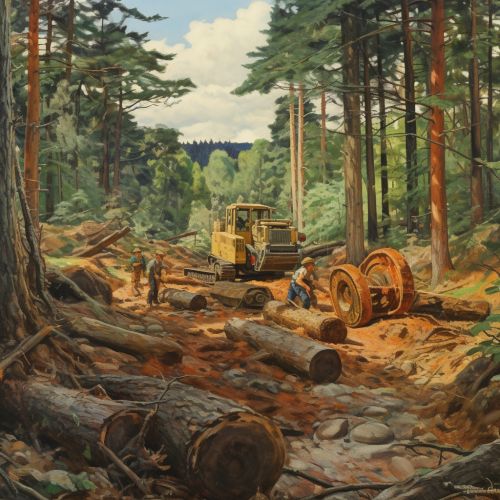Habitat destruction
Introduction
Habitat destruction is a phenomenon that involves the alteration, degradation, or complete eradication of the natural environment in which organisms live. This process often results in the reduction or extinction of biodiversity, and is considered one of the primary threats to endangered species worldwide.


Causes of Habitat Destruction
Habitat destruction can be caused by a variety of human activities. These include deforestation, urban sprawl, agriculture, mining, and pollution. Each of these activities has a significant impact on the environment, often leading to the loss of habitats for many species.
Deforestation
Deforestation is the process of clearing forests for various purposes such as timber harvesting, agriculture, and urban development. This activity not only destroys the habitats of forest-dwelling species but also contributes to climate change by reducing the amount of carbon dioxide that forests can absorb.
Urban Sprawl
Urban sprawl refers to the expansion of human populations away from central urban areas into previously remote and rural areas, often resulting in habitat destruction. This is often driven by population growth and the desire for larger homes and yards.
Agriculture
Agriculture, particularly industrial agriculture, often involves the clearing of large areas of land for the cultivation of crops or the rearing of livestock. This can lead to the loss of natural habitats, particularly in areas with high biodiversity such as rainforests.
Mining
Mining activities, especially those that involve open-pit or strip mining, can lead to significant habitat destruction. These activities often involve the removal of large amounts of soil and rock, which can destroy the habitats of many species.
Pollution
Pollution, particularly in the form of industrial waste, can also lead to habitat destruction. This can occur when pollutants contaminate the soil, water, or air, making the environment unsuitable for many species.
Effects of Habitat Destruction
The effects of habitat destruction are far-reaching and can have significant impacts on both local and global ecosystems. These effects include the loss of biodiversity, changes in ecosystem services, and impacts on human societies.
Loss of Biodiversity
One of the most significant effects of habitat destruction is the loss of biodiversity. When habitats are destroyed, the species that rely on them often cannot survive, leading to population declines and even extinctions. This loss of biodiversity can have significant impacts on ecosystem function and stability.
Changes in Ecosystem Services
Habitat destruction can also lead to changes in ecosystem services, which are the benefits that humans derive from ecosystems. These include services such as water purification, climate regulation, and pollination. When habitats are destroyed, these services can be disrupted or lost entirely.
Impacts on Human Societies
Finally, habitat destruction can have significant impacts on human societies. Many people rely on natural resources for their livelihoods, and the destruction of habitats can lead to the loss of these resources. Additionally, the loss of ecosystem services can have significant economic impacts.
Conservation and Restoration
Given the significant impacts of habitat destruction, there are many efforts underway to conserve and restore habitats. These include protected areas, restoration projects, and sustainable land use practices.
Protected Areas
Protected areas, such as national parks and wildlife reserves, are one of the most common strategies for conserving habitats. These areas are often set aside specifically to protect certain species or ecosystems.
Restoration Projects
Restoration projects aim to restore degraded habitats to their natural state. This can involve activities such as reforestation, wetland restoration, and the reintroduction of native species.
Sustainable Land Use Practices
Sustainable land use practices aim to balance human needs with the needs of the environment. This can involve practices such as sustainable agriculture, sustainable forestry, and smart growth urban planning.
Conclusion
Habitat destruction is a significant environmental issue that has far-reaching impacts on biodiversity, ecosystem services, and human societies. However, through conservation and restoration efforts, it is possible to mitigate some of these impacts and preserve habitats for future generations.
